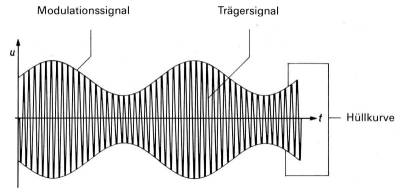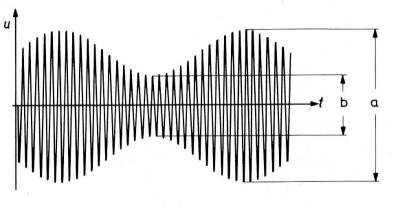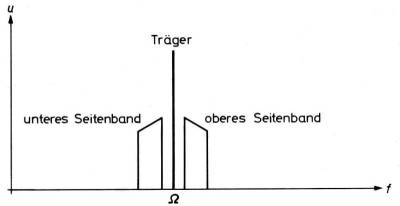Reception modes
There are several possibilities to add information to a bare RF signal. In the early days of wireless communication, Morse code was transmitted by simple on-off keying of a signal, later in the 1930s, radio telephony was introduced. Spoken information and tones were modulated onto a carrier signal.
In modern transmitters, different modulation modes can be selected; on the receiving side, the operation mode must be correctly set in order to demodulate the signal.
A1
 Continuous wave or CW is the name of the operation mode in which an unmodulated carrier is transmitted in rhythm with Morse code; sometimes this mode is referred to as unmodulated telegraphy.
Continuous wave or CW is the name of the operation mode in which an unmodulated carrier is transmitted in rhythm with Morse code; sometimes this mode is referred to as unmodulated telegraphy.
On the transmitter side, the transmission technique is quite simple by simply keying or interrupting the transmitted signal. But for demodulation, the signal must be mixed with a telegraphy superheterodyne oscillator to make it audible; in a simple AM radio receiver, only a slight hiss in the rhythm of Morse code is audible.
With the switch Beat frequency oscillator or BFO, the signal of the auxiliary oscillator is activated, usually a control allows to adjust the frequency of the BFO and thus the pitch of the Morse signal in the headphones.
CW signals can also be made audible with an audion receiver, in which the regeneration is turned up so much, that the circuit starts to oscillate.
A2
In the operation mode A2 or modulated telegraphy (MCW), the carrier signal is modulated with a tone frequency (in the early days of transmitter technology, the frequency of the power generator was used for this purpose) ans is transmitted in the rhythm of Morse code.
In contrast to the unmodulated carrier of a CW transmitter, the signal in A2 can be heard in a normal AM receiver. Even with a simple detector the signal can be demodulated, that's why this operation mode allowed the construction of very simple receivers in the early days of radiotelegraphy.
A3
 For medium and long wave broadcasting and also for telephony operation in military communications in the early years, amplitude modulation is used. The signals can be demodulated by simple receivers, starting from the crystal detector as well as with a complex superhet receiver, without the need for a telegraphy superheterodyne oscillator. The modern designation for this type of modulation is A3E.
For medium and long wave broadcasting and also for telephony operation in military communications in the early years, amplitude modulation is used. The signals can be demodulated by simple receivers, starting from the crystal detector as well as with a complex superhet receiver, without the need for a telegraphy superheterodyne oscillator. The modern designation for this type of modulation is A3E.
 The audio frequency modulates the width of the wave envelope of the transmitted signal; the modulation index is calculated from (a-b)/(a+b) * 100%. A simple crystal detector or a tube or semiconductor diode is sufficient for demodulation.
The audio frequency modulates the width of the wave envelope of the transmitted signal; the modulation index is calculated from (a-b)/(a+b) * 100%. A simple crystal detector or a tube or semiconductor diode is sufficient for demodulation.
 With amplitude modulation, the transmitted energy as well as the bandwidth requirement is hight: a major part of the transmitter energy is „wasted“ in the carrier signal, which however does not transfer any information. Due to the identical audio information in both sidebands, the signal covers more than twice the width of the highest transmitted sound frequency. This means a signal with high audio quality requires more bandwidth, a narrowband signal becomes dull and difficult to understand.
With amplitude modulation, the transmitted energy as well as the bandwidth requirement is hight: a major part of the transmitter energy is „wasted“ in the carrier signal, which however does not transfer any information. Due to the identical audio information in both sidebands, the signal covers more than twice the width of the highest transmitted sound frequency. This means a signal with high audio quality requires more bandwidth, a narrowband signal becomes dull and difficult to understand.
Ampitude-modulated signals are susceptible to propagation disturbances (fading) and noise from static discharges and sparks from generators, motors, etc.
A3J
 The contemporary designation of the operation mode Single Sideband is J3E.
The contemporary designation of the operation mode Single Sideband is J3E.
For more efficient use of the transmitted energy and bandwidth, single sideband modulation is used: In this mode, only one sideband containing the modulated voice or audio information is transmitted. The transmission of a carrier and an identical second sideband (with actually redundant information) is left away. The entire output of the transmittier tube can thus be used for the transmission of information.
As the second sideband is not transmitted, also bandwidth in the frequency spectrum can be saved.
SSB signals are less susceptible to selective fading and noise from ignition sparks.
When single sideband modulation is used, the upper or lower sideband can be transmitted, if the wrong setting is selected at the receiver, the transmission becomes unintelligible. In military and commercial communications, the use of the upper sideband (USB) is standard; in amateur radio, on frequencies below 10 MHz LSB is used and on frequencies above 10 MHz USB is standard.
For demodulation, an auxiliary carrier must be mixed with the antenna signal to replace the carrier signal. In high-quality receivers, an oscillator with a fixed frequency difference to the intermediate frequency is used; in simpler sets, the BFO (beat frequency oscillator) is used for this. To improve speech intelligibility, the signal replacing the carrier must be at the correct distance from the single-sideband signal. If the offset is too small or too big, the speaker's voice may sound like Mickey Mouse. Fine tuning with small tuning increments is therefore absolutely required for single-sideband reception.
A special operation mode is the transmission of a signal with different audio information in both sidebands (usually with suppressed carrier), called ISB, „independent side band“. This modulation type A3B (or B8E) was used for shortwave feeds of different language programmes of international shortwave broadcasting services to their relay stations.
F3
 Frequency modulation, modern designation F3E came into use with American military equipment operating in the VHF range in the last years of World War II.
Frequency modulation, modern designation F3E came into use with American military equipment operating in the VHF range in the last years of World War II.
On frequency bands above 30 MHz or the high end of the shortwave range, the signal bandwidth or channel spacing is of less importance. FM signals have a much better audio quality and intelligibility, it is easier to work with squelch, and fading is hardly a relevant transmission problem.
With a frequency-modulated transmitter, the frequency of signal is slightly varied depending on the audio modulation. In the receiver, the use of a limiter (to eliminate remaining amplitude-modulated signal components that cause interference) and a discriminator for demodulation is necessary, and the circuitry is significantly more complex.
In contrast to VHF broadcasting, which uses a channel spacing of 100 kHz (sometimes 50 kHz), in military and official land mobile communication (police, firearms,etc.) a channel spacing of 50 kHz, which has been reduced to 25 kHz or even 12.5 kHz in new generations of equipment is used. However, the frequency response and voice transmission quality of so-called NBFM (Narrow Band FM) transmissions is reduced.
FSK
For Radio teletype, the FSK method („Frequency Shift Keying“, former designation F1, modern F1B) is standard. In the simplest case, the transmitter frequency for the two states „Mark“ and „Space“ (corresponding to 0 and 1) is shifted by a certain amount („Shift“, can usually be preselected on the radioteletype demodulator).
Alternatively, a single sideband signal can be modulated with an audio signal with two different pitches to transmit the teletype signals, this mode is called „Audio Frequency Shift Keying“ (AFSK).
A similar operation mode is „facsimile“, the transmission of image data in a frequency modulated signal. The abbreviation of this mode is F4 according to the old designation or F1C according to the modern designation.
Hell
A completely different teletype method is the Hell method named after Rudolf Hell. In this pseudo facsimile method, all letters are converted into a 7×7 dot matrix and these impulses are transmitted as tone signals with an AM transmitter.
On the receiver side, the Hell signals are fed to the Hell printer. A printing screw electromagnetically presses an ink ribbon onto a paper strip and thus prints the text as plain text on a telegram paper strip.
In Switzerland, commercially available Hell printers from Siemens were used at Army high power stations in the 1940s, but the Hell printer in Switzerland never saw field use like the German Feld-Hell printer.
